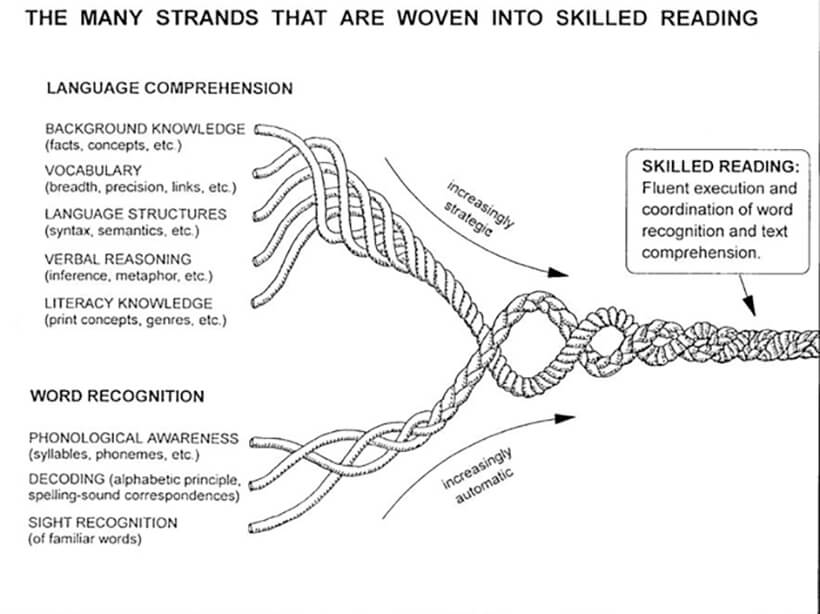Too many children leave primary school unable to read well, as the UK continues to face entrenched educational underachievement when it comes to children’s reading competency – often with the most vulnerable children suffering.
Out of the children who are unable to read well by the end of Year 6, over a third of them are disadvantaged pupils. This results in a knock-on, damaging effect in terms of a child’s further education, employment, and life chances.
Blossom Educational speaks to expert phonics trainer, Pamela Heath, about the common mistakes surrounding phonics and how to avoid them.

There have been shifts towards reading being the underpinning driver in all educational settings for the last 5 years, with several campaigns championing the necessity for all children to be able to read to learn.
Read on, Get on has been an ongoing coalition campaign which was introduced in 2015 by major literacy and communication charities, teaching unions, and publishers. It is focused on ensuring that every child can read well by age 11 by 2025.
Early learning and development around reading are vital in this national focus, as statistics highlight the likelihood of a child being behind with reading at age 11 if they are assessed as being below a good level of development in Early Years Foundation Stage (EYFS).
This is where phonics comes in. We managed to get in touch with the wonderful Pamela Heath, who has worked for the past 12 years as an expert phonics deliverer for Sounds Write (one of only 19 phonics programme providers which have been validated by the Department for Education).
Pamela, following teaching for several years supporting the non-readers, currently guides all practitioners, from childminders to teachers, through everything they need to know about phonics.

Using these experiences, plus her wisdom gained as an advisory teacher since 2007, she shared her invaluable insights with Blossom.
With guidance from Pamela, we have collated the 5 biggest mistakes nursery settings make when organising phonics-based activities for their children, and how to avoid these!
What is phonics and who teaches it?
Phonics is a selection of knowledge that a child must learn and understand in order to read and spell effectively. The importance of teaching phonics has indisputable evidence, with the Education Endowment Foundation considering it the most secure area of pedagogy.
The use of a systematic phonics programme was made statutory for EYFS school settings in 2013 with the revisited National Curriculum and is assessed by the Phonics Screening Test which is undertaken in Year 1.
Phonics uses the English alphabet code to teach the links between letters and the sound they make. It also works to develop the skills needed to blend sounds, which enables the actual reading of the word.
For example, phonics teaches us that the graphemes in g-oa-t all have different sounds and what those sounds are (grapheme-phoneme correspondence GPC). Then it allows us to blend them together to read the word: goat.
Phonics is required to be taught as a formal programme from Year 1. However, the EYFS Framework 2021 refers to the first stages of systematic phonics, through their non-statutory guidance when assessing good levels of development:
Early Learning Goal: Word Reading
Children at the expected level of development will:
- Say a sound for each letter in the alphabet and at least 10 digraphs.
- Read words consistent with their phonic knowledge by sound-blending.
- Read aloud simple sentences and books that are consistent with their phonic knowledge, including some common exception words.
Phase 1 of phonics surrounds language and communication development, one of the prime areas of learning for Early Years, making the need to start their phonics journey crucial.

Why is phonics so difficult?
The English language is one of, if not the, hardest language to learn as a non-native – and as a native too! The English alphabetical code has developed alongside historical changes, religion, invasions, and trade collaborations, making the rules of reading and spelling a melting pot without hard and fast structures.
The 26 letters in the alphabet represent either singularly or in a combination of others a whopping 44+ phonemes. As a comparison, in the Spanish, German or Welsh language, one grapheme (letter/s) almost always represents the same phoneme (sound).
Let’s get our heads around this!
One grapheme can represent a solitary phoneme– big, fish.
Different graphemes can be used to represent the same phonemes (different ways of spelling the same sound):
- old
- boat
- crow
- toe
- stone
- dough
A grapheme can represent different phonemes in different words (the same spelling but different sounds):
- neat
- head
- great
Phonics gives the children the key to unlocking this complex alphabetic code for reading and spelling. There are a plethora of phonics programme options to choose from, and Pamela advises that whichever you choose to use, do it well!
As we can see just how confusing the concept of phonics can be, misconceptions with a puzzling concept can significantly delay the child’s progression into phase 2 learning.
Top 5 mistakes nurseries make with phonics, and how to avoid them!
Some nurseries express concerns around the age of the children, mainly: when should phonics be formally ‘taught’? When are the children ready to begin learning phonics? These concerns are supported in the Curiosity Approach.
Remember, the Early Years is a learning time in its own right, with time to explore and develop vital language and communication skills. Pamela explains, ‘It is never too early for language development, linking to the prime areas of learning, phonics teaching is not an all or nothing approach’.
Here are some of the most common mistakes to avoid when planning a provision to support the foundation of phonics learning:
Teaching letter names instead of sounds
Early Learning Goals surrounding word reading suggest a good level of development including the knowledge of sounds for each letter in the alphabet, as well as 10 digraphs. A common mistake can be the teaching of the letter names of the alphabet: A (Ay), B (Be), C(See).
Giving a fantastic explanation, Pamela explains:
If you teach children the letter names before the sounds, you will find errors with their understanding of phonemes when they begin learning to spell simple words.
Let’s see if you can spot the common error. Sound this word out, saying the capital as you would for a letter name:
As the R will be pronounced AR, many phonic programmes make a point to teach letter names after the children are secure with the letter sounds to avoid such a problem. Were we trying to read start or strut?
The alphabet song therefore could potentially be causing misconceptions! Try looking at pure sounds with your children instead. Check out this video on the pronunciation of pure sounds.
Cognitive overload
For information to be transferred from the working memory to the long-term memory, it must be transferred as efficiently as possible. This means the removal of additional load, including confusing or non-essential information, as well as minimising distractions. Minimal distractions in Early Years, sounds reasonable…
Activities can sometimes be chosen with all good intentions; thinking the game will be engaging and active, the children will enjoy participating and will therefore remember the task they completed.
However, overly ‘busy’ games or tasks can put unnecessary pressure on the young children’s cognitive load capacity, reducing the effectiveness of the learning.
Example
For example, working as a small group the task is to find words with the same sounds and spellings (cat and bat would be paired). The children all get a word each, they will read their word and try to find their partner when the music plays (a phonics musical statue if you will).
Once the music stops, they rush around and try to find their letter and sound partner. This activity could be an example of limited learning due to cognitive overload.
To avoid this ensure the activity allows enough time and space for the children to practice the skill needed. Early years children need oral and visual stimulation to assist with their learning, as they rely on sensory stimulation to support their brain to process the information with which they are presented.
When choosing an activity, delve deep into the reason why you have chosen this game or task. Ask yourself: will they have an engaging yet purposeful activity to help develop the specific skill of focus?
Activity choices that can hinder learning
Bringing us to another linked common mistake: the choice of the activity. It is mentioned by the founders of the Curiosity Approach the reason why you choose a task or resource is the most important factor. It must develop specific emotional, social, personal, or academic skills within the child.
The main goal when introducing phonics centred activities is to increase the ability to read and spell by applying their phonetic knowledge. These activities must be high quality, practical to deliver, and efficient.
One of the largest mistakes found with phonics-related activities are the limited time spent practising word reading due to the choice of activities. These are thought to be engaging and fun, but actually remove the integrity of the learning behind it.
Different to cognitive overload, these activities may over or under-stimulated learning. Resources such as the sandpit, water tray, painting stations, and using sensory writing materials are excellent vehicles to encourage language development.
These also boost social skills, cooperative play, fine motor skills, and imagination and creativity, but to use them as the main methods to access phonics learning misses the fundamental reason for the activity. The reason why must be constantly asked when choosing activities.
Fishing for the correct phoneme can be engaging for the child, but can significantly reduce the length of time spent on learning, the Rose Review explains.
If you’re unsure which phonics programme may be suitable for your setting as an introduction to phase 1, you can find information from the DfE here.
The details matter
Children often begin to have spaces for their belongings in nurseries, pegs or trays for their masterpieces. The small details can often be missed, Pamela explains. She gives an excellent example of peg labels that link with an animal to help practise starting letter sounds. Can you spot the incorrect choice?
The G (ju) sound at the beginning of Gemma’s name is a different sound to the G (guh) of the beginning of goat, a simple error that could develop into misconceptions or limit the child with opportunities for exposure and practise of the sounds and spellings.
Take a quick look around your setting, are there any confusing images used on displays?
There's more than phonics to reading
Phonics makes a huge impact on improving children’s ability to read and spell, with research demonstrating the number of children who reached the expected standard in the Phonics Screening Check taken in Year 1 before synthetic phonics programmes were introduced to be 58%.
After using a systematic phonics programme for the teaching of phonics, the following year’s data increased to 82% meeting the expected Year 1 standard. However, phonics allows children to understand the sounds and then blend to read the words, it does not teach them the meaning behind those words.
The Scarborough Reading Rope explains the need for language comprehension as well as word recognition when creating strong readers. Pamela warned some may think strong reading is about memory and guessing skills when reading new words.
However, these children with strong visual memories may struggle with the comprehension of what they are reading, stagnating their progress later in their educational careers.
The two strands that weave together when taught high-quality reading skills include:
Word recognition
Phonological awareness, decoding and sight recognition of familiar words.
Language comprehension
Background knowledge, vocabulary, language structures, verbal reasoning and literacy knowledge.

When facilitating high-quality activities surrounding language and talk, explain the words through meaning in stories or through physical objects. To learn more about how to develop a language-rich environment, check out our article on how to do this here.
Although there are no statutory requirements for nurseries to follow a phonics programme, it is incredibly useful for your team to know what your children will be tackling when they move onto primary school.
The play opportunities and language development readily available in nurseries make it the perfect setting for children to begin their phonics journey.
Subscribe to receive expert advice and tips from seasoned professionals in the early years sector.